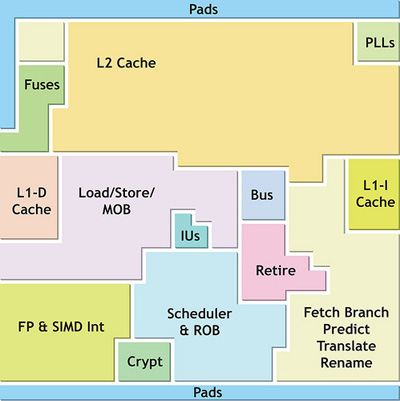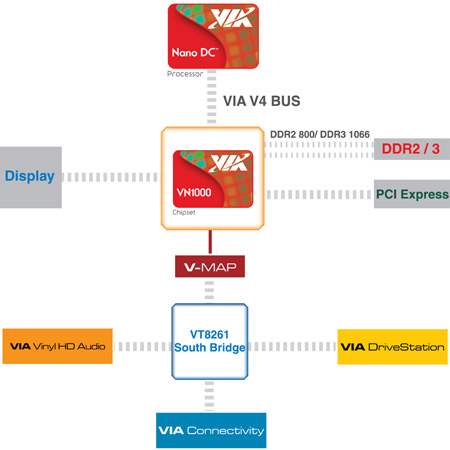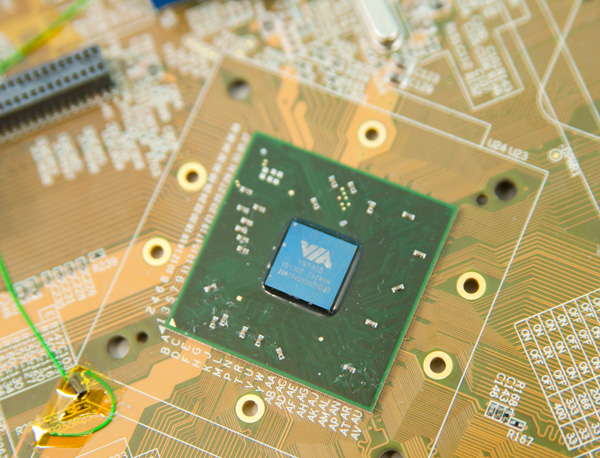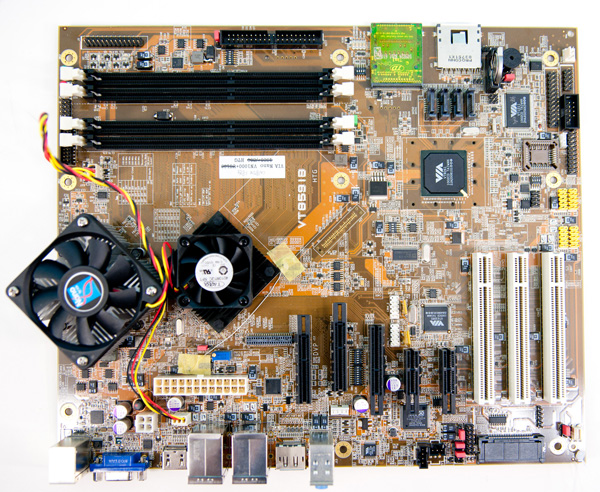VIA's Dual Core Nano & VN1000 Chipset Previewed
by Anand Lal Shimpi on November 15, 2010 12:26 PM ESTI haven’t had an official product briefing with VIA in years. The last time I met with a representative from the company was two years ago outside of IDF in San Francisco. Before then, it was probably around 4 years.
VIA was the first casualty of integration in the PC space. Today we’re all talking about moving graphics onto the processor die, but a few years ago we were having similar discussions about moving the memory controller and north bridge on die. As a manufacturer of chipsets (north and south bridges) for CPUs, VIA lost relevance in the x86 CPU market as the need for a third party chipset maker faded.
VIA’s recent visit to me in Raleigh, NC had two purposes according to the company. One, to remind me that VIA was still around and to give me some face to face time with a VIA representative (appreciated). And two, to showcase VIA’s dual-core Nano platform and brand new integrated graphics chipset (intriguing).
For those of you who don’t know, Nano is VIA’s answer to Atom, except it came along long before Atom did. Just like Atom, Nano was designed in Texas but by VIA’s Centaur team - a microprocessor company it acquired several years back. Centaur’s speciality was low power microarchitectures, and Nano is exactly that.

Compared to Atom, Nano is a bit of a beast. Both Atom and AMD’s Bobat core can fetch and issue up to two instructions. Nano can do three. Like AMD’s Bobcat, Nano has a full out of order execution engine. Atom, for the time being, is in-order.
The execution engine is well matched to the front end. Nano features seven dispatch ports and can retire up to three instructions per clock. In this sense, Nano is more like AMD’s Bobcat than Intel’s Atom. In fact, those two should be better matched than Atom vs. Nano.

VIA's Nano
Nano has other advantages over Atom. It features a hardware encryption engine. Something VIA introduced long before Intel’s AES-NI in Westmere. All of these features come at the expense of power consumption. Nano should be faster, but it draws more power than Atom.
VIA is a fabless semiconductor manufacturer, its Nano processor and associated chipset are both fabbed at TSMC in Taiwan. Nano is currently a 65nm design although VIA plans to take it to 40nm in 2011.
The dual-core Nano that VIA dropped off is architecturally identical to the existing Nano. Similar to the dual-core CPUs, DC Nano is literally two Nano die placed alongside one another. The L2 caches are private and all core-to-core communication happens externally via the Nano’s latest chipset: VIA’s VN1000. The dual-core die measures 8.5 mm x 16 mm (136mm^2 total area) on a 21 mm x 21 mm BGA package.
Ironically enough, VIA hasn’t integrated a memory controller into its own CPU design. Although to VIA’s credit, the CPU’s performance is competitive without it. I suspect VIA will deliver a more integrated version of Nano within the next 12 - 18 months.
While the dual core Nano improves competitiveness with Intel’s Atom, it’s the VN1000 that’s a huge step forward. These days everyone is talking about graphics and VIA is no exception. The VN1000 integrates S3’s Chrome 520, a brand new DirectX 10 GPU. VIA was light on architectural details other than to state that it has 32 stream processors and 4 texture sampling units. The VN1000 die is nearly as big as the CPU at 100mm^2 on a 65nm process. VIA claims that the 520’s performance is easily good enough for mainstream graphics.

Armed with a reference ATX motherboard, I was eager to verify those claims. Note that this review appears a lot later than expected as our original DC Nano reference board was damaged in transport. It wouldn't do anything beyond POST so what you're looking at is our second sample.













54 Comments
View All Comments
nitrousoxide - Monday, November 15, 2010 - link
The true competitor for Nano DC will be the AMD Bobcat, which can sweep out Atom as well as this Nano chip with ease. The Fusion APU will simply dominate such market until Intel come up with a fast-enough-Atom.nitrousoxide - Monday, November 15, 2010 - link
When are we gonna see it? Anand said that the review should be available last week :(JessusChristDoOTcom - Monday, November 15, 2010 - link
Why do we have to click on "Read more" button on the buttom of the front page article previews where there is a picture there that could be made to be clicked upon to get us to the very same place? Why not make front page preview pictures clickable leading readers directly into the first page of the article? I think it would make alot of sense and would make browsing alot smoother not to mention potential for finger clicking in touchscreen applications.nitrousoxide - Monday, November 15, 2010 - link
agreed...that helps a lot with touch screens...Vepsa - Monday, November 15, 2010 - link
if this comes in way under atom in price, i can see it being used for lots of smoothwall/pfsense/clearos/etc routers. i know i'd love an atom box for my router, but the price makes it so i can't.yzkbug - Monday, November 15, 2010 - link
Anand, could you clarify the power consumption vs. Radeon HD 5450? The original 5450 review (http://www.anandtech.com/show/2931/14) states that the total idle power is 121W (as opposed to 37.8 here). Thanks!mattgmann - Monday, November 15, 2010 - link
This all looked great until the power consumption page. I don't see this chip as direct competition to atom. Their power usage profiles are completely different.In fact, I bet you could build and i3 system that could have similar consumption and loads more performance.
For what applications exactly are they marketing these boards?
Zoomer - Monday, November 15, 2010 - link
Office machines, POS terminals, the like? That's a huge market.It would be really awesome for these apps, esp. once they power gate it.
mattgmann - Tuesday, November 16, 2010 - link
That's what I figured, but I think there are better options for those applications already in the market. Step in the right direction for via, but it's tough playing catchup to amd and especially intel.ClagMaster - Monday, November 15, 2010 - link
The DC Nano and VN1000 are fine achievements for VIA. Bravo !!!If they can get the process down to 40nm AND implement better power management, they would have a winner.
At 40W, this is still an excellent low power performer for the cost.
This could easily play DX8/9 games available 4 years ago on 1600 x 1200 resolution.